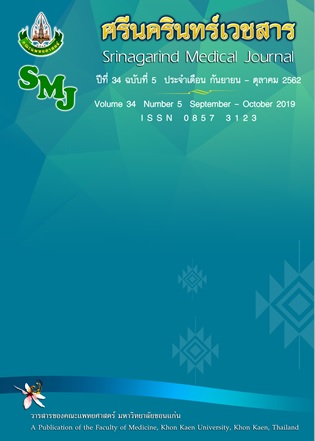Learning Resources in the 21st Century for Promoting Lifelong Learning in Medical Education
Keywords:
Medical EducationAbstract
Learning resources help students learn new knowledge and skills. The examples of learning resources are textbooks, colleagues and journals. To prepare self-directed and lifelong learning, students should know how to use learning resources effectively. Using resources should be in a sequence of searching, evaluation, decision, and application. After the students use evidence in learning resources, they will have direct experience. Instructors and medical schools should explore problems and obstacles of using learning resources to help students fulfil their learning need.
References
2. Partnership for 21st Century Learning Skills. Framework for 21st Century Learning [Internet]. [cited 2019 January 01]. Available from: www.P21.org
3. ณัฏฐลักษณ์ ธาระวานิช, แหล่งการเรียนรู้ในศตวรรษที่ 21 เพื่อส่งเสริมการเรียนรู้ตลอดชีวิตของประชาชน. ใน: สุวิธิดา จรุงเกียรติกุล. การศึกษาและการเรียนรู้ตลอดชีวิต. กรุงเทพมหานคร: สำนักพิมพ์แห่งจุฬาลงกรณ์มหาวิทยาลัย, 2557.
4. สำนักงานเลขาธิการสภาการศึกษา. การศึกษาเปรียบเทียบการพัฒนาการศึกษาไทยกับนานาชาติ: นวัตกรรมด้านการเรียนรู้ตลอดชีวิตเพื่อยกระดับการศึกษาเพื่อแรงงานไทย. กรุงเทพมหานคร: สำนักงานเลขาธิการสภาการศึกษา, 2549.
5. Barros R. From lifelong education to lifelong learning: discussion of some effects of today’s neoliberal policies. European Journal for Research on the Education and Learning of Adults 2012; 3: 2: 119-134.
6. อาชัญญา รัตนอุบล. คำจำกัดความ แนวคิด และลักษณะการศึกษาตลอดชีวิต. ใน: สุวิธิดา จรุงเกียรติกุล, บรรณาธิการ. การศึกษาและการเรียนรู้ตลอดชีวิต. กรุงเทพมหานคร: สำนักพิมพ์แห่งจุฬาลงกรณ์มหาวิทยาลัย, 2557.
7. สำนักงานคณะกรรมการศึกษาแห่งชาติ. รายงานสรุปการสัมมนายุทธศาสตร์การเรียนรู้ตลอดชีวิต. กรุงเทพมหานคร: องค์การค้าคุรุสภา, 2543.
8. Kelly L. Community-based medical education. In Kelly L. Community-based medical education: a teacher’s handbook. London: Radcliffe Publishing, 2012.
9. Benbassat J. Role modeling in medical education: the importance of a reflective imitation. Acad Med 2014; 89: 550–4.
10. Achkar MA, Hanauer M, Morrison EH, Davies MK, Oh RC. Changing trends in residents-as-teachers across graduate medical education. Adv Med Educ Pract 2017: 8: 299-306.
11. Jauregui J, Bright S, Strote J, Shandro J.A novel approach to medical student peer-assisted learning through case-based simulations. West J Emerg Med 2018; 19: 1: 193–197.
12. Mathur R. What is the importance of textbook [Internet]? [cited 2019 January 16]. Available from:
https://www.quora.com/What-is-the-importance-of-textbook
13. Berg AO, Atkins D, Tierney W. Clinical practice guidelines in practice and education. J Gen Intern Med 1997; 12 (Suppl2): S25–S33.
14. Holt RI, Miklaszewicz P, Cranston IC, Russell-Jones D, Rees PJ, Sönksen PH. Computer assisted learning is an effective way of teaching endocrinology. Clin Endocrinol (Oxf) 2001; 55: 4: 537-42.
15. Masters K, Ellaway RH, Topps D, Archibald D, Hogue RJ. Mobile technologies in medical
education: AMEE Guide No. 105. Med Educ 2016; 38: 6: 537-49.
16. Goldberg LR, Crocombe LA. Advances in medical education and practice: role of massive open online courses. Adv Med Educ Pract 2017; 8: 603–9.
17. Work the World. Medical electives overseas: healthcare placements for medical students [Internet]. [cited January 15,2019]. Available from: https://www.worktheworld.com.au/medical-electives




